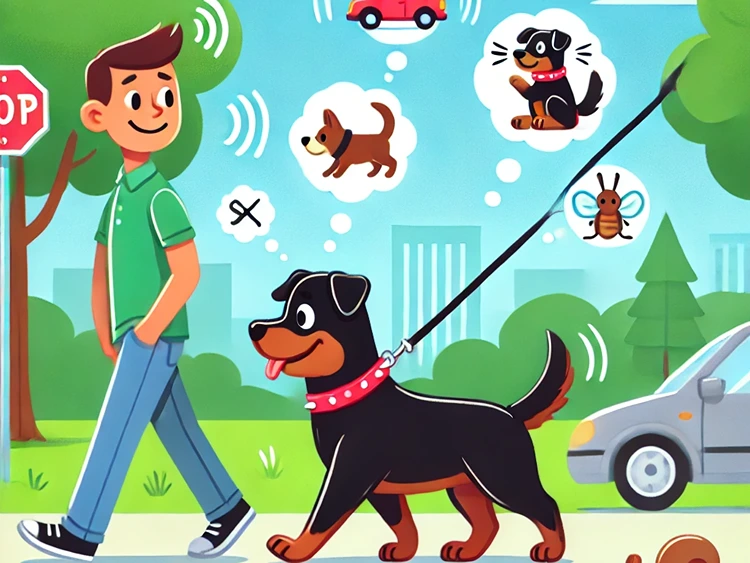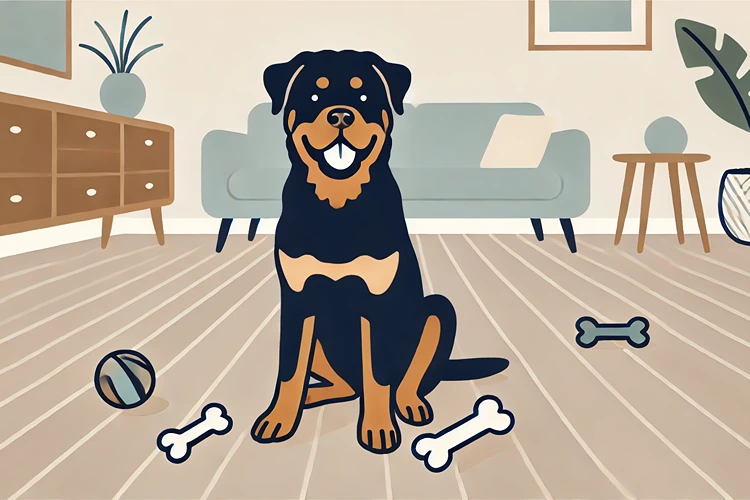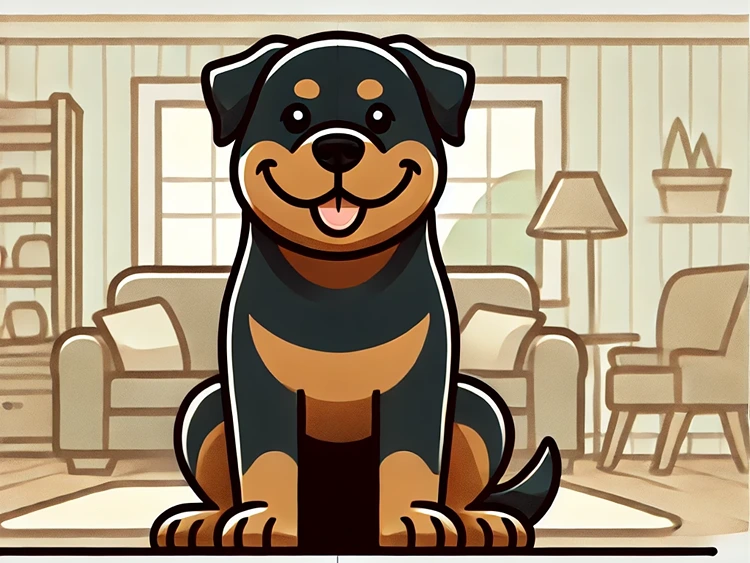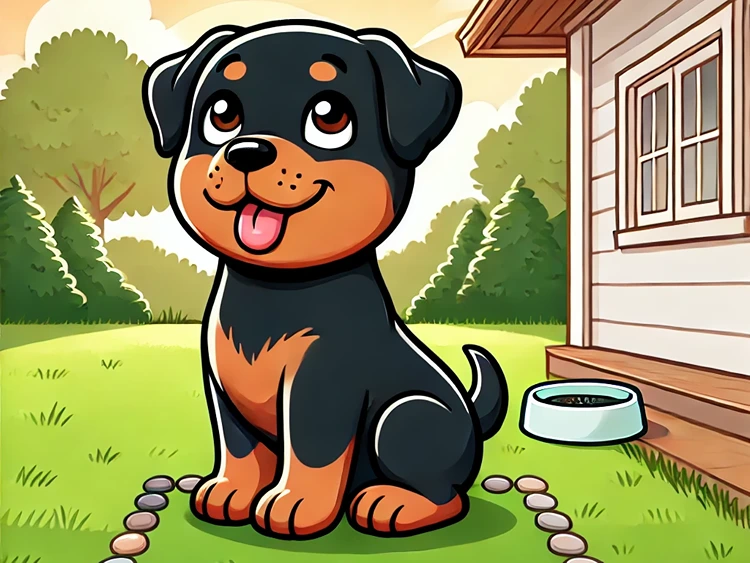Walking your Rottweiler can be a delightful experience—until they start reacting to every little distraction. Whether it’s a squirrel, a passing car, or another dog, these distractions can turn a peaceful walk into a chaotic one. Training your Rottweiler to ignore distractions during walks is not only essential for your peace of mind but also for their safety. Let’s dive into the process of transforming your Rottweiler into a well-mannered walking companion.
Why Do Rottweilers Get Distracted on Walks?
Rottweilers are intelligent and strong-willed dogs, known for their alertness and protective nature. These traits, while admirable, can sometimes lead to distractions during walks. Understanding why your Rottweiler gets distracted is the first step in addressing the issue.
- Natural Instincts: Rottweilers have a strong prey drive, meaning they are naturally inclined to chase after animals like squirrels or birds. This instinct can make it challenging for them to stay focused during walks.
- Curiosity: Like many dogs, Rottweilers are curious by nature. New sights, sounds, and smells can easily capture their attention, leading to distractions.
- Protective Behavior: Rottweilers are known for their loyalty and protective instincts. They may perceive other dogs or people as potential threats, causing them to become distracted or reactive.
Paw-some Tip:
Understanding the root cause of your Rottweiler’s distractions can help you tailor your training approach. Are they more likely to chase after animals, or do they react to other dogs? Identifying their triggers is key to successful training.
How to Prepare for Distraction Training
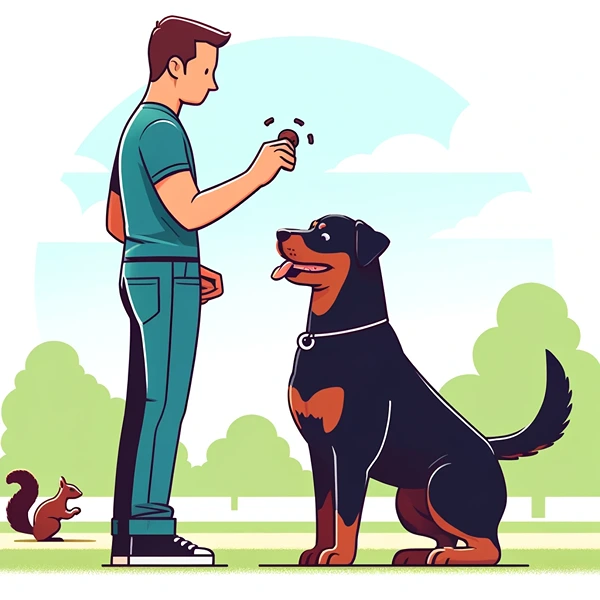
Before you begin training your Rottweiler to ignore distractions, it’s essential to set the stage for success. Preparation is key, and with the right tools and mindset, you can make the training process smoother and more effective.
Gather the Necessary Tools
To train your Rottweiler effectively, you’ll need a few essential tools:
- High-Value Treats: Use treats that your Rottweiler loves but doesn’t get often. These should be something special that will motivate them to focus on you instead of the distraction.
- Leash and Harness: A sturdy leash and a well-fitting harness are crucial. They give you control without causing discomfort to your Rottweiler.
- Clicker (Optional): A clicker can be a useful tool for marking good behavior. It helps your Rottweiler understand exactly what they did right to earn a reward.
Set Clear Goals
Before you start, define what you want to achieve with the training. Do you want your Rottweiler to ignore other dogs completely, or are you looking for them to stay calm when passing by distractions? Clear goals will help you stay focused and track your progress.
Paw-some Tip:
Start with small, manageable goals. For example, begin by training your Rottweiler to stay calm when a distraction is at a distance, then gradually decrease the distance over time.
Effective Training Techniques to Ignore Distractions
Training your Rottweiler to ignore distractions is all about consistency and positive reinforcement. Here are some proven techniques that can help you achieve this goal.
Focus Training: Teaching Your Rottweiler to Pay Attention to You
Focus training is one of the most effective ways to get your Rottweiler to ignore distractions. The idea is to teach your dog to look at you and wait for your commands instead of reacting to what’s happening around them.
- Start in a Distraction-Free Environment: Begin training in a quiet area where there are minimal distractions. This could be your backyard or a quiet room in your house.
- Use a Command: Choose a command like “Look at me” or “Focus.” Say the command and when your Rottweiler makes eye contact, immediately reward them with a treat.
- Practice Regularly: Repeat this exercise regularly. Once your Rottweiler consistently responds to the command, gradually introduce distractions.
- Increase the Challenge: As your Rottweiler improves, practice in more challenging environments, like a park or a busier street. The goal is to maintain their focus on you, even when there are distractions around.
Desensitization: Gradually Reducing Sensitivity to Distractions
Desensitization involves exposing your Rottweiler to distractions in a controlled way, gradually increasing their exposure over time. This method helps your dog become accustomed to distractions and reduces their sensitivity.
- Identify Triggers: Start by identifying the distractions that your Rottweiler reacts to the most, such as other dogs, cyclists, or cars.
- Start at a Distance: Begin by exposing your Rottweiler to these distractions from a distance where they remain calm. Reward them for staying focused on you.
- Gradually Decrease Distance: Slowly decrease the distance between your Rottweiler and the distraction, continuing to reward them for calm behavior.
- Be Patient: This process can take time, so be patient and don’t rush it. The key is to move at your dog’s pace.
Redirection: Shifting Focus from the Distraction
Redirection is a useful technique for when your Rottweiler becomes fixated on a distraction. The goal is to redirect their attention back to you using a command or a treat.
- Use a Command: When you notice your Rottweiler fixating on a distraction, use a command like “Leave it” or “Come here.”
- Reward Immediate Response: As soon as your Rottweiler responds to the command and shifts their focus back to you, reward them with a treat.
- Practice Regularly: The more you practice this, the quicker your Rottweiler will learn to shift their focus away from distractions.
Common Rottweiler Distractions and How to Address Them
| Distraction | Recommended Training Technique | Success Tip |
|---|---|---|
| Other Dogs | Desensitization and Focus Training | Start with controlled exposure at a distance and gradually reduce the distance over time. |
| Cars | Command Training and Redirection | Use commands like “Heel” or “Stay” when cars approach and reward calm behavior. |
| Wildlife | Leave It Command and Leash Control | Keep the leash short initially, and gradually give more slack as your dog learns to stay calm. |
| People | Desensitization and Positive Reinforcement | Start training in a less crowded area and gradually expose your Rottweiler to busier environments. |
Paw-some Tip:
Combine redirection with focus training to reinforce the desired behavior. When your Rottweiler redirects their attention to you, immediately use your focus command and reward them for complying.
Common Challenges and How to Overcome Them
Training a Rottweiler to ignore distractions is not without its challenges. Understanding these obstacles and how to overcome them can help you stay on track.
What If My Rottweiler Doesn’t Respond to Training?
If your Rottweiler is struggling to ignore distractions despite your best efforts, don’t lose hope. Some dogs take longer to train than others, and that’s okay. Here are some tips to help you get back on track:
- Evaluate Your Approach: Take a step back and evaluate your training methods. Are you using high-value treats? Is your timing for rewards accurate? Small adjustments can make a big difference.
- Increase the Value of Rewards: If your Rottweiler isn’t motivated by the treats you’re using, try switching to something they find more irresistible.
- Break It Down: If the training is too challenging, break it down into smaller steps. Make the process as simple as possible and gradually increase the difficulty.
How to Handle Setbacks in Training
It’s normal to experience setbacks during the training process. The key is to remain patient and consistent. If your Rottweiler regresses or struggles with a particular distraction, take a step back and reinforce the basics before moving forward again.
Remember, training is a journey, and setbacks are part of the process. Stay positive, and your Rottweiler will eventually learn to stay focused during walks.
Maintaining Consistency and Reinforcing Training
Consistency is crucial when training your Rottweiler. Without it, your dog may become confused and revert to old behaviors. Here’s how to maintain consistency and reinforce your training efforts.
Why Is Consistency Important in Training?
Consistency helps your Rottweiler understand what is expected of them. By using the same commands, rewards, and techniques every time, you reinforce the desired behavior, making it more likely that your dog will continue to perform well.
How to Reinforce Training Over Time
Even after your Rottweiler has learned to ignore distractions, it’s important to continue reinforcing this behavior:
- Regular Practice: Incorporate short training sessions into your daily routine to keep the behavior fresh in your Rottweiler’s mind.
- Use Random Rewards: Occasionally reward your Rottweiler for ignoring distractions during walks. This keeps them motivated and reinforces the behavior.
- Stay Patient: Remember that consistency doesn’t mean perfection. There may be days when your Rottweiler struggles more than others, and that’s okay.
Rottie Stats:
According to a survey of dog owners, 73% reported that consistent training improved their dog’s ability to ignore distractions over time.
Advanced Techniques for Handling Specific Distractions

Once your Rottweiler has mastered the basics of ignoring distractions, it’s time to move on to more advanced training. Different distractions may require specific strategies, especially if your Rottweiler has strong reactions to particular triggers like other dogs, cars, or wildlife.
How to Handle Distractions from Other Dogs
Other dogs are often one of the biggest challenges when walking a Rottweiler. Their protective instincts and natural curiosity can make it difficult to stay calm and focused. Here’s how to address this:
- Practice at a Distance: Start by exposing your Rottweiler to other dogs from a distance where they remain calm. Gradually decrease the distance as your dog gets more comfortable.
- Use a High-Value Distraction: Keep your Rottweiler’s favorite treat or toy handy. When another dog approaches, use it to redirect their focus back to you.
- Train in Different Settings: Practice this training in various settings—quiet neighborhoods, busy parks, etc.—to ensure your Rottweiler can handle different environments.
Paw-some Tip:
If your Rottweiler gets overly excited or anxious around other dogs, consider scheduling playdates with well-behaved dogs in a controlled environment. This can help them learn to interact calmly.
What to Do When Your Rottweiler Reacts to Cars
Cars, especially fast-moving ones, can be a significant distraction for Rottweilers. Their natural prey drive might kick in, causing them to want to chase after the vehicle. To prevent this, use the following strategies:
- Practice in a Safe Area: Begin by walking your Rottweiler in a quiet area with minimal traffic. Gradually introduce them to busier streets as they become more comfortable.
- Use a Command: Teach your Rottweiler a specific command like “Heel” or “Stay” when cars approach. Reward them for staying calm and focused.
- Desensitize Over Time: Slowly increase exposure to cars by walking along busier streets or near parking lots, always rewarding calm behavior.
Managing Reactions to Wildlife and Small Animals
Wildlife and small animals, such as squirrels or birds, are common distractions that can trigger your Rottweiler’s prey instincts. Here’s how to manage these situations:
- Increase Distance: If your Rottweiler reacts strongly to wildlife, start by increasing the distance between them and the animal. Gradually decrease this distance as they learn to stay calm.
- Use a “Leave It” Command: Teach your Rottweiler a command like “Leave it.” Practice this command in various situations, rewarding them for ignoring the animal and focusing on you.
- Leash Control: Keep a firm grip on the leash and ensure it’s short enough to prevent your Rottweiler from lunging at the animal. Gradually allow more slack as their behavior improves.
Why Consistency in Training Matters
Consistency is the backbone of successful training. Without it, your Rottweiler may become confused and revert to old habits. Here’s why staying consistent is so important:
How Inconsistency Affects Training Progress
Inconsistent training can lead to mixed signals, making it harder for your Rottweiler to understand what’s expected of them. If you only enforce rules occasionally or allow certain behaviors in some situations but not others, your dog may become confused.
- Confusion: If your Rottweiler isn’t sure what behavior is expected, they may revert to old habits.
- Regression: Inconsistent training can cause your dog to regress, undoing progress you’ve made.
- Behavioral Issues: Lack of consistency can lead to new behavioral problems as your Rottweiler tries to figure out what is acceptable.
How to Stay Consistent in Training
Maintaining consistency doesn’t have to be difficult. Here are some practical tips to help you stay on track:
- Stick to the Same Commands: Use the same commands every time you want your Rottweiler to perform a specific action. This helps them learn faster and prevents confusion.
- Regular Practice: Incorporate short training sessions into your daily routine. Regular practice reinforces good behavior and keeps the training fresh in your dog’s mind.
- Involve All Family Members: Make sure everyone in your household is on the same page with the training. Consistency across the board ensures your Rottweiler receives the same message from everyone.
How to Make Walks Enjoyable for Both You and Your Rottweiler
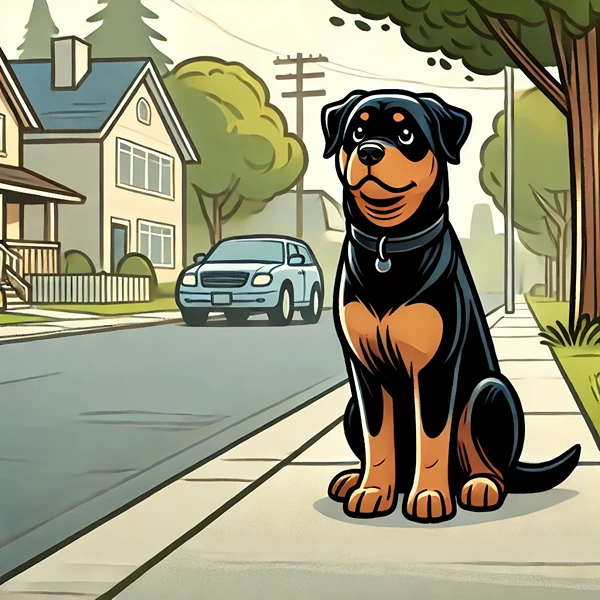
Training your Rottweiler to ignore distractions is crucial, but it’s also important to ensure that walks are enjoyable for both of you. Here are some tips to make your walks more pleasant:
What Makes Walks Enjoyable for Your Rottweiler?
For your Rottweiler, a walk isn’t just about exercise—it’s also a time to explore, sniff, and experience the world. To make walks more enjoyable for your dog:
- Allow Time to Sniff: Dogs experience the world through their noses, so give your Rottweiler time to sniff around. This not only makes the walk more enjoyable for them but also provides mental stimulation.
- Vary Your Route: Try taking different routes during your walks. New environments offer fresh sights and smells, keeping your Rottweiler engaged and excited.
- Incorporate Play: Bring along a favorite toy or find a safe area to let your Rottweiler run and play. This adds an element of fun to the walk and helps burn off excess energy.
How to Ensure Your Walks Are Stress-Free
Your enjoyment of the walk is just as important as your Rottweiler’s. To make walks less stressful and more enjoyable for you:
- Stay Calm and Patient: If your Rottweiler becomes distracted, stay calm and patient. Reacting with frustration can increase your dog’s anxiety and make the situation worse.
- Use a Comfortable Harness: Ensure your Rottweiler’s harness is comfortable and doesn’t cause chafing or discomfort. A well-fitting harness gives you better control without causing pain.
- Be Prepared: Always carry treats, water, and waste bags. Being prepared for any situation makes the walk smoother and more enjoyable.
How to End Walks on a Positive Note
Ending your walks on a positive note reinforces good behavior and leaves your Rottweiler with a sense of accomplishment:
- Give a Final Command: Before ending the walk, give a final command, like “Sit” or “Stay,” and reward your Rottweiler for obeying.
- End with a Treat: Once you’ve returned home, give your dog a treat to reinforce the positive experience.
- Provide Praise: Always end with praise, letting your Rottweiler know they did a great job during the walk.
FAQs
Wrapping Up
Training a Rottweiler to ignore distractions during walks is a rewarding journey that requires patience, consistency, and a deep understanding of your dog’s unique personality. By using the right techniques, such as focus training, desensitization, and redirection, you can help your Rottweiler become a well-mannered and confident walking companion.
Remember, the key to success is consistency—reinforcing positive behavior over time and ensuring that everyone involved in the training process is on the same page. Whether you’re dealing with distractions from other dogs, cars, or wildlife, the effort you put into training will pay off in the long run.
By focusing on making walks enjoyable for both you and your Rottweiler, you’ll not only improve your dog’s behavior but also strengthen the bond you share. Continue practicing these techniques, and soon enough, your Rottweiler will be walking calmly by your side, no matter what distractions come your way.
Happy training, and may your walks be peaceful and enjoyable!

